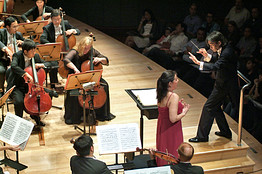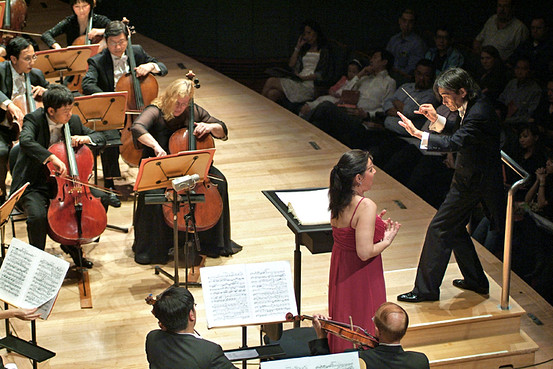By JAMIE JAMES
Singapore
At a rehearsal for the 1910 premiere of his opera "Elektra," Richard Strauss stopped the titanic duel between the soprano and the orchestra, one of the largest ever assembled at that time, by shouting at the conductor: "Louder! Louder! I can still hear her!" After leading the first rehearsal himself, Strauss had concluded that he lacked the stamina to supervise the 100-minute-long musical siege himself, and surrendered the baton to Ernst von Schuch. Strauss wrote "Elektra" with the avowed intention of topping the sensation created by his previous opera, the scandalous "Salome," by pushing "the outermost limits of harmony, psychological polyphony, and the receptivity of modern ears."
A setting of Hugo von Hofmannstahl's relentlessly grim adaptation of Sophocles' tragedy of betrayal and revenge in the house of Atreus, "Elektra" scored an immediate success at its premiere and has been a fixture in the international repertory ever since. While there was never any doubt of the work's astonishing originality and technical mastery, from the beginning a suspicion has lingered that the work was a cynical exercise in transgressive shock, pouring on the musical gore and cranking up the volume to 11.
Last week, a concert performance of the work by the Singapore Symphony Orchestra, led by the American conductor Kent Nagano, discovered something weirdly approaching lyricism in the piece. Mr. Nagano, who is preparing a series of performances of "Elektra" in February at the Bavarian State Opera in Munich, where he is general music director, made his name as a Straussian 20 years ago with a recording of the French-language version of "Salome" with the Lyon Opera, which struck some listeners as a shade too perfumed and sparkling. His "Elektra" in Singapore was a fascinating performance of scrupulous musicianship and interpretive intelligence that managed to elicit passages of delicate transparency without losing the brute sonic power the piece requires.
Like many great opera anecdotes, Strauss's cry of "Louder! Louder!" may be apocryphal, but the composer took pains to defend "Elektra" against the accusation that his score was a mugging by orchestra. In an essay written 14 years later, he claimed that if his complex dynamic markings were properly observed, every word would be distinctly audible. In Singapore, a fine cast of singers was able to convey the nuance as well as the horror of Hofmannstahl's tale of a daughter possessed by the desire for her own mother's death, as revenge for murdering her father.
The American soprano Janice Baird brought the title role to life with an intensity that was at times genuinely unsettling. Ms. Baird made a spectacular, unplanned debut at the Metropolitan Opera last year, in the middle of Act II of "Tristan und Isolde," after Deborah Voigt, singing the role of Isolde, took ill and fled the stage mid-duet. After a 10-minute warm-up, Ms. Baird finished that evening with a performance that had the Met's audience on its feet cheering. In Singapore, her voice shone with a dark, glossy patina that endowed even the score's ugliest moments with a spectral beauty. She seemed confined by the limitations of the concert platform; one sensed that she wanted to grovel in stage dirt with dogs, as the scenario demands.
If Dagmar Hesse, the glamorously beautiful German soprano who took the part of Chrysothemis, seemed lightweight by comparison, it was only appropriate to the role of Elektra's bourgeois sister, who just wants to get married and have kids, and is appalled by her sister's lust for the blood of their mother, Klytaemnestra. Danish mezzo-soprano Susanne Resmark as the guilt-tormented Klytaemnestra was a redoubtable foil to Ms. Baird's Elektra, recounting her hideous nightmares, set to the opera's most challenging, chromatic orchestrations, with chilling rhetorical finesse.
Yet the orchestra is always the star of "Elektra," and if it was an act bordering on classical hubris for the Singapore Symphony Orchestra to undertake this fiendishly difficult score, in the event they played with precision and feeling -- with an even larger force (119 players) than that at the work's premiere. At moments of stress, the strings were slightly overpowered, but balances overall were fine, and the voices were always crisply present, even at the soft end of the dynamic range.
Mr. Nagano and the Singaporeans were aided in this aural clarity by their superb concert hall at the Esplanade performing arts center, which opened in October 2002. The sonic environment, created by the legendary American acoustician Russell Johnson, has gained a reputation among expert listeners as one of the best halls in the world. The Esplanade, on the edge of a busy harbor, was built to be an icon like the Sydney Opera House and the Guggenheim Bilbao. Its two vast, organically shaped domes, clad in an aluminum armor of "fish scale" sunscreens, have been variously likened to the eyes of a fly, armadillos, and, locally, two halves of a durian, Asia's notoriously stinking fruit, which has a thorny rind.
It hasn't been a case of Singapore simply pouring millions into another striking architectural monument. Many of the lavish cultural palaces built in Asia over the past 10 years are struggling to find sustainable programming, yet in the island state they are creating an audience to fill the halls. Friday's unique performance of "Elektra" competed with a lavish production of Rodgers and Hammerstein's "Cinderella" starring Lea Salonga, a performance in the small studio theater by an avant-garde Spanish company, and a free jazz concert in a band shell at the water's edge. And if the SSO's programming isn't exactly venturesome, neither does it shrink from the difficult. In May the orchestra will perform Berlioz's demanding masterpiece "La Damnation de Faust" -- a jolly picnic after "Elektra."
Mr. James is the author of "The Snake Charmer" (Hyperion), a biography of the herpetologist Joe Slowinski.





![[poe]](https://webarchive.library.unt.edu/eot2008/20090116002641im_/http://s.wsj.net/public/resources/images/ED-AI858_Poe_C_20090114114647.jpg)
![[Low Fat, Aisle 2: Grocer to Flag Healthful Foods]](https://webarchive.library.unt.edu/eot2008/20090116002641im_/http://s.wsj.net/public/resources/images/PJ-AO077_pjSUPE_C_20090114170441.jpg)
![[How Jazz Helped Civil Right]](https://webarchive.library.unt.edu/eot2008/20090116002641im_/http://s.wsj.net/public/resources/images/ED-AI862_jazzcr_C_20090114214637.jpg)
![[Obama t-shirts]](https://webarchive.library.unt.edu/eot2008/20090116002641im_/http://s.wsj.net/public/resources/images/OB-CY451_0114in_C_20090114130437.jpg)
![[In Cuba, Judaism Becomes Rite of Passage]](https://webarchive.library.unt.edu/eot2008/20090116002641im_/http://s.wsj.net/public/resources/images/OB-CY377_cubaje_C_20090113200440.jpg)
![[Identifying Blue Chips, Post-Meltdown]](https://webarchive.library.unt.edu/eot2008/20090116002641im_/http://s.wsj.net/public/resources/images/OB-CY379_walmar_C_20090113204405.jpg)
![[Web Searches That Really Bear Fruit]](https://webarchive.library.unt.edu/eot2008/20090116002641im_/http://s.wsj.net/public/resources/images/PJ-AO043_pjMOSS_C_20090113130846.jpg)
![[California]](https://webarchive.library.unt.edu/eot2008/20090116002641im_/http://s.wsj.net/public/resources/images/PR-AB248_BLUEPR_C_20090113142619.jpg)
![[Elektra]](https://webarchive.library.unt.edu/eot2008/20090116002641im_/http://s.wsj.net/public/resources/images/ED-AI850_electr_C_20090113121349.jpg)
![[David Swensen]](https://webarchive.library.unt.edu/eot2008/20090116002641im_/http://s.wsj.net/public/resources/images/MI-AU521_SWENSE_C_20090112134143.jpg)
![[airline passenger]](https://webarchive.library.unt.edu/eot2008/20090116002641im_/http://s.wsj.net/public/resources/images/OB-CY217_midsea_C_20090112202455.jpg)
![[Judd, trash]](https://webarchive.library.unt.edu/eot2008/20090116002641im_/http://s.wsj.net/public/resources/images/OB-CY094_Juddfa_C_20090112124927.jpg)


Hello
Your question to the Journal Community Your comments on articles will show your real name and not a username.Why?
Create a Journal Community profile to avoid this message in the future. (As a member you agree to use your real name when participating in the Journal Community)